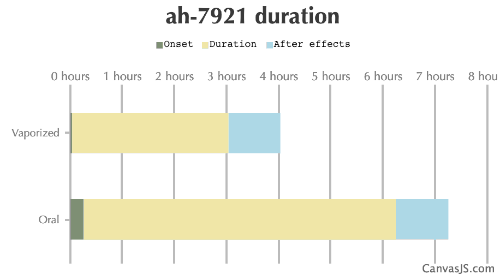[ Home ] [ Controlled Substances ] [ Opioids ]
AH-7921
|
AH-7921 is an N-substituted cyclohexylmethylbenzamide classified as an opioid analgesic with high addictive liability. In animal studies, AH-7921 produced typical morphine-like actions, i.e., antinociception, respiratory depression, sedation, miosis, inhibition of gut propulsion, and lowered body temperature, with a potency almost equipotent to that of morphine. There is limited information available on the routes of administration and the doses of AH-7921 used. The compound is taken orally, nasally, by smoking, and, less commonly, by intravenous injection. Minimal oral effective doses for complete pain suppression by AH 7921 are 1.25 and 13.8 mg/kg for canine and rhesus monkey, respectively.
 (3,4-Dichloro-N-([1-(dimethylamino)cyclohexyl] methyl)benzamide):
(3,4-Dichloro-N-([1-(dimethylamino)cyclohexyl] methyl)benzamide):
https://drugs.ncats.io/drug/10BR7A0SO0
Synthetic opioid AH-7921 is a designer drug that is relatively new and has been raising alarm as individuals worldwide seek it out in an attempt to get high or self-medicate their pain. Abusing any kind of drug is dangerous, but this drug is not fully understood by the scientific community and can cause serious damage to a person's health and life.
AH-7921 was originally created in the 1970s by Allen and Hanburys Ltd. (hence, the 'AH') in an attempt to develop an analgesic medicine, however, further production ceased due to its apparent addictive qualities. This compound has never been sold commercially or reputably as a medicine, nor as a substance with pharmaceutical, medicinal, or industrial applications.
AH-7921, also called doxylam and doxylan, is a new psychoactive substance, which is structurally similar to fentanyl, and having a potency that is described as comparable to morphine.

https://www.rehabcenter.net/synthetic-opioid-ah-7921/
World Health Organization 2014:
AH-7921 is a synthetic opioid. It has been available particularly in Europe since mid-2012.The first detailed experience reports on AH-7921 appeared in early 2013 on the Erowid website. In one of the reports, the vapours of a total of 40 mg of the free amine (powdery crystal) were inhaled during a 30 min period. The peak-effects lasted for 1.5 h and were described as 'like a relaxed morphine effect mixed with a medium oxycodone/hydrocodone buzz'.
EMCDDA - Risk Assesment 2014:
AH-7921 is a structurally unique synthetic opioid analgesic that was first identified in a collected sample purchased from an Internet retailer in July 2012, and the United Kingdom formally notified the Early Warning System in August 2012. It was invented and patented by the London-based company Allen & Hanburys Limited in the mid-1970s but was not developed into a medicine. AH-7921 is typically encountered as a powder. The substance has no established or acknowledged medical (human or veterinary) use in the European Union.

 EMCDDA Risk Assesment 2014 (PDF 22 pages):
EMCDDA Risk Assesment 2014 (PDF 22 pages):
http://www.emcdda.europa.eu/system/files/publications/774/TDAK14002ENN_480892.pdfEMCDDA - Europol Joint Report 2014:
- AH-7921 is a synthetic opioid.
- It has been available in the European Union since at least July 2012 and has been detected in seven EU Member States and Norway.
- In most cases it has been seized in small quantities as a powder.
The similarity of AH-7921 to morphine in terms of pharmacology is a key concern. This may play an important role in the further spread of AH-7921 by opioid users, including the injecting population.

 EMCDDA - Europol Joint Report 2014 (PDF 15 pages):
EMCDDA - Europol Joint Report 2014 (PDF 15 pages):
https://www.emcdda.europa.eu/system/files/publications/816/AH-7921_465209.pdf
| Duration: It has around 80% the potency of Morphine when taken orally. | |||
| Route | Onset | Duration | After Effects |
|---|---|---|---|
| Tripsit Factsheets | |||

AH-7921: http://drugs.tripsit.me/ah-7921 | |||
| Vaporized: | 2-10 minutes | 3-4 hours | 1-6 hours |
| Oral: | 15-45 minutes | 6-8 hours | 1-6 hours |

| |||
Aliases:
| |||
| Effects: Euphoria, Dry Mouth, Mood lift, Itchiness, Relaxant, Constipation, Pupil constriction, Analgesia. | |||

https://erowid.org/experiences/subs/exp_AH7921.shtml
AH-7921 has never progressed to clinical trials. The DEA is not aware of any medical usage in the United States, and has not insisted the Health and Human Services department (HHS) to conduct any medical research of the substance's uses. AH-7921 was extensively studied in vitro and in animals, though not in humans, by the developing company, it was never sold commercially for medical use.
- An opioid analgesic
- Discovered in the 1970s
- 90% the potency of morphine when administered orally
- Has been sold on the internet since 2012 as a research chemical
- When sold online it may be called the alternative name doxylam
With doses that usually range from 10 to 150 mg, users are likely to experience effects similar to heroin, morphine, and fentanyl such as euphoria and respiratory depression. When an overdose occurs users often experience tachycardia, hypertension, and seizures.
A 2018 review of published case reports found a total of 14 cases, of which 13 resulted in death
AH-7921 is considered a new psychoactive substance (NPS) in which it is synthetically created in laboratories to mimic that of controlled substances.

| Opioids | Link to this page |





